Drugging the addict: non-oncogene addiction as a target for cancer therapy
- PMID: 27702988
- PMCID: PMC5090709
- DOI: 10.15252/embr.201643030
Drugging the addict: non-oncogene addiction as a target for cancer therapy
Abstract
Historically, cancers have been treated with chemotherapeutics aimed to have profound effects on tumor cells with only limited effects on normal tissue. This approach was followed by the development of small-molecule inhibitors that can target oncogenic pathways critical for the survival of tumor cells. The clinical targeting of these so-called oncogene addictions, however, is in many instances hampered by the outgrowth of resistant clones. More recently, the proper functioning of non-mutated genes has been shown to enhance the survival of many cancers, a phenomenon called non-oncogene addiction. In the current review, we will focus on the distinct non-oncogenic addictions found in cancer cells, including synthetic lethal interactions, the underlying stress phenotypes, and arising therapeutic opportunities.
Keywords: cancer; non‐oncogene addiction; synthetic lethality; therapy; vulnerability.
© 2016 The Authors. Published under the terms of the CC BY NC ND 4.0 license.
Figures

References
Publication types
MeSH terms
LinkOut - more resources
Full Text Sources
Other Literature Sources

